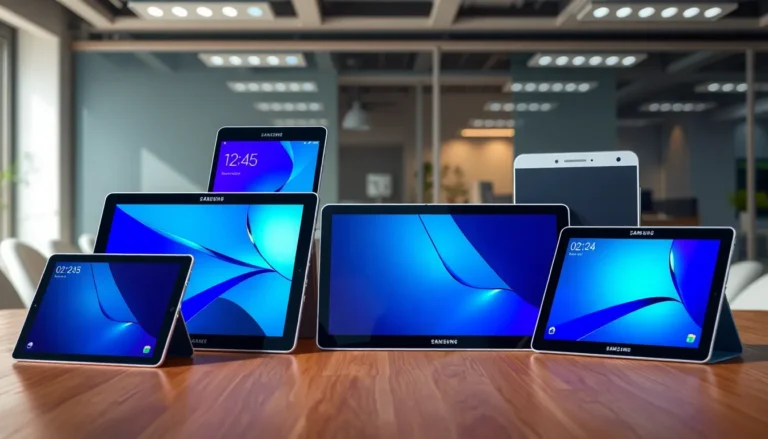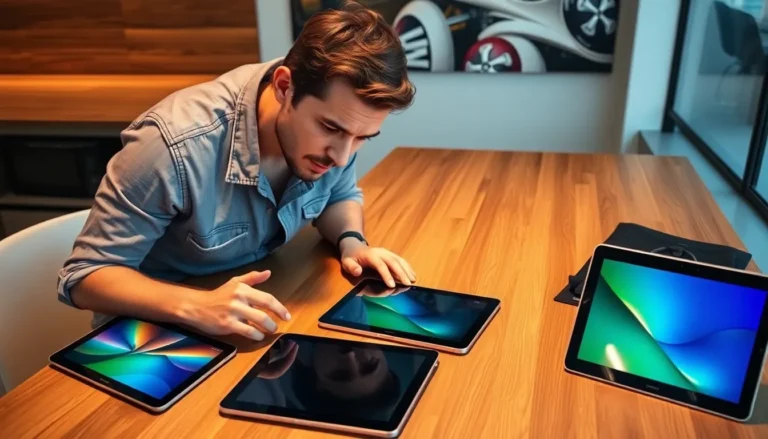In the battle of the screens, tablets and laptops are like the odd couple of the tech world. One’s sleek and portable, perfect for binge-watching the latest series while lounging on the couch. The other’s a powerhouse, ready to tackle spreadsheets and presentations like a pro. So, which one should you take home to meet the family?
Choosing between a tablet and a laptop isn’t just a tech decision; it’s a lifestyle choice. Are you a digital nomad who needs something light and versatile, or a serious multitasker who craves the comfort of a full keyboard? With both options offering unique benefits, it’s time to dive into the details and find out which device will become your new best friend—or at least your trusty sidekick.
Table of Contents
ToggleOverview of Tablet vs Laptop
Tablets and laptops serve different purposes, catering to various user needs. A tablet is characterized by its touch interface, lightweight design, and portability. Many use tablets for casual activities, such as browsing the internet or watching videos, making them suitable as secondary or travel devices. Performance may vary with models, with high-end tablets capable of multitasking and running demanding applications.
Conversely, laptops provide more power and versatility. Laptops typically feature larger screens, full keyboards, and advanced processing capabilities. Professional environments often rely on laptops for tasks such as programming, graphic design, and data analysis. Many business users appreciate the ability to run complex software that allows for efficient multitasking.
Battery life also differs between these devices. Tablets tend to last longer on a single charge due to their less demanding hardware. Some high-end laptops, however, now compete closely in battery performance. Users looking for prolonged use without frequent charging often gravitate toward tablets.
Pricing varies significantly among tablets and laptops. Entry-level tablets can be substantially less expensive than budget laptops. Users seeking high-performance options in either category should prepare for higher costs associated with premium devices.
Ultimately, the choice hinges on individual lifestyle needs. Those prioritizing portability and casual use may prefer tablets, while users requiring performance and functionality will likely favor laptops. Understanding these differences aids readers in making informed decisions on which device suits their specific requirements.
Key Features Comparison

Understanding the key features of tablets and laptops helps determine which device best fits specific needs.
Performance
Laptops typically excel in performance due to their advanced processors and larger RAM. High-end models can handle intensive tasks such as video editing or coding seamlessly. Tablets, while improving in capability, still lag behind in processing power for resource-heavy applications. They often rely on mobile processors, which limits their multitasking ability. Device choice depends on usage patterns; demanding workflows favor laptops, whereas casual browsing suits tablets.
Portability
Tablet designs prioritize portability, featuring lightweight frames that easily fit in bags. Users enjoy the convenience of quickly pulling out a tablet on public transport or during travel. Laptops, though portable, weigh more and can be bulkier. Some ultrabook models challenge this perception with slim profiles and light weights. Selecting the right device depends on lifestyle; portable tablets appeal to frequent travelers, while laptops offer better performance for mobile workstations.
Battery Life
A tablet’s battery typically lasts longer than that of a laptop, making them suitable for extended use away from power sources. Many tablets provide around 10 to 15 hours of active use. Some high-end laptops have improved significantly, boasting up to 12 hours of battery life, but they still struggle in comparison. Daily requirements influence battery choice; frequent travelers or casual users benefit from the longevity of tablets, while professionals often require laptops for intensive tasks.
Usage Scenarios
Tablets and laptops serve distinct purposes, catering to different user needs across various scenarios.
For Students
Students benefit from the portability of tablets, making them perfect for classroom note-taking and group study sessions. Lightweight and easy to carry, tablets fit into backpacks without hassle. Many educational apps designed for tablets enhance learning, allowing for interactive experiences through touch interfaces. Battery life typically exceeds that of laptops, letting students participate in all-day classes without worrying about charging. Some high-end tablets support keyboard attachments, allowing for efficient typing when writing papers or doing assignments. While tablets suit casual use, those engaging in more complex projects may find laptops better for programming or extensive research tasks.
For Professionals
Professionals often require robust performance for tasks like presentations, data analysis, and creative work. Laptops typically outperform tablets in these areas due to their advanced processors and larger RAM. Professionals can leverage extensive software applications that run smoothly on laptops, optimizing productivity in demanding environments. Versatile connectivity options make laptops ideal for office setups or remote work. Despite their bulkiness, many professionals prefer laptops for multitasking across various applications. Tablets, although improving, might not handle intensive workloads as efficiently, limiting their use for high-performance tasks in corporate settings.
Price Comparison
Tablets generally feature lower price points compared to laptops, making them more accessible for budget-conscious consumers. Entry-level tablets typically start around $200, while budget laptops often begin at approximately $300. Premium tablets, however, can reach prices exceeding $1,000, similar to high-end laptops equipped with advanced features.
Decision making in this area often hinges on the specific needs of the user. The price for high-performance laptops can range from $800 to over $2,500, especially for models designed for gaming or professional use. In contrast, premium tablets may offer extensive connectivity options and superior displays but still lag behind in processing power when compared to top-tier laptops.
In addition, essential accessories frequently add to the total cost. A good-quality keyboard or stylus, commonly purchased for tablets, can increase expenses by $100 or more. Laptops, while already equipped with integrated keyboards, may require additional investments in peripherals like external monitors or storage devices for enhanced functionality.
Moreover, resale values differ significantly between the two devices. Laptops often depreciate more quickly, while tablets may retain a stronger resale value if maintained well. This aspect can impact long-term costs, making tablets a worthwhile investment for some users.
Ultimately, understanding these price differences helps users make informed choices based on their financial constraints. Weighing the price against performance needs can clarify whether a tablet or a laptop becomes the more cost-effective solution.
Choosing between a tablet and a laptop ultimately hinges on personal preferences and usage needs. For those who prioritize portability and casual use a tablet often shines with its lightweight design and long battery life. However for users needing robust performance and multitasking capabilities a laptop remains the go-to option.
Understanding the specific requirements for work or leisure can guide individuals in making the right choice. Whether it’s for educational purposes professional tasks or everyday entertainment both devices have their unique advantages. Evaluating these aspects ensures that users select the device that best fits their lifestyle and budget.







